The ESMER Model
Understanding the Complexity of the Self
Guy Tonella
Bioenergetic Analysis • The Clinical Journal of the IIBA, 2022 (32), 145–159
https://doi.org/10.30820/0743-4804-2022-32-145 CC BY-NC-ND 4.0 www.bioenergetic-analysis.comAbstracts
Biological life and living organisms appeared about 4 billion years ago. They have become increasingly complex in the course of evolution. The human Self is the current culmination of this incredible complexification. This process and its results are presented in this paper. First the double origin of the Self, biological and social, will be presented. Then the structural development of the Self with its five functions – from bottom to top: Energetic, Sensorial, Muscular, Emotional and Representational functions – will be explained. This complex development of the human Self underlies the “ESMER Model”. Then, the functional development of the Self will be presented as well as the developmental problems that arise. Evolution managed to organize the Self into an integrated and self-regulated system by developing four kinds of interconnections between the five functions of the Self. And finally, these four kinds of interconnections will be at the origin of four modes of interpersonal relationships.
Keywords: self, complexification, ESMER, interconnections, interpersonal
Modelo “ESMER”
Compreendendo a Complexidade do Self (Portuguese)
A vida biológica e os organismos vivos apareceram há mais ou menos $ bilhões de anos. Eles não pararam de tornar-se cada vez mais complexos no curso dessa evolução. O Self humano é a culminância atual dessa incrível complexificação. Este processo e seus resultados estão apresentados neste artigo. Primeiro a dupla origem do Self, biológico e social, será apresentada. Em seguida o desenvolvimento estrutural do Self com as suas cinco funções (de baixo para cima: Função energética, sensorial, muscular, emocional e representacional) será explicado. Esse desenvolvimento complexo do Self humano define o “Modelo ESMER”. Então o desenvolvimento do Self será apresentado bem como os problemas de desenvolvimento que podem surgir. A evolução conseguiu organizar o Self em um sistema integrado, autorregulado, através do desenvolvimento de quatro tipos de interconexões entre as cinco funções do Self. E finalmente, estes quatro tipos de interconexões darão origem a quatro modos de relações interpessoais.
Modello “ESMER”
Comprendere la complessità del sé (Italian)
La vita biologica e gli organismi viventi sono comparsi circa 4 miliardi di anni fa. Non hanno cessato di diventare sempre più complessi nel corso dell’evoluzione. Il Sé umano è l’attuale culmine di questa incredibile complessità. In questo lavoro sono presentati questo processo e i suoi risultati. In primo luogo verrà presentata la doppia origine del Sé, biologica e sociale. Verrà poi spiegato lo sviluppo strutturale del Sé con le sue cinque funzioni (dal basso verso l’alto: funzioni energetiche, sensoriali, muscolari, emotive e rappresentative). Questo complesso sviluppo del Sé umano è alla base del “Modello ESMER”. Quindi, verrà presentato lo sviluppo funzionale del Sé e i problemi di sviluppo che potrebbero sorgere. L’evoluzione è riuscita a organizzare il Sé in un sistema integrato e autoregolato sviluppando quattro tipi di interconnessioni tra le cinque funzioni del Sé. E infine, questi quattro tipi di interconnessioni saranno all’origine di quattro modalità di relazioni interpersonali.
Le model “ESMER”
Comprendre la complexité du Soi (French)
La vie biologique et les organismes vivants sont apparus il y a environ 4 milliards d’années. Ils n’ont cessé de devenir de plus en plus complexes au cours de l’évolution. Le Soi humain est l’aboutissement actuel de cette incroyable complexification. Ce processus et ses résultats sont présentés dans cet article. Tout d’abord, la double origine du Soi, biologique et sociale, sera présentée. Ensuite, le développement structurel du Soi avec ses cinq fonctions (de bas en haut: fonctions énergétique, sensorielle, musculaire, émotionnelle et représentationnelle) sera expliqué. Ce développement complexe du Soi humain est à la base du "Modèle ESMER". Puis, le développement fonctionnel du Soi sera présenté ainsi que les problèmes de développement qui pourraient survenir. L’évolution a réussi à organiser le Soi en un système intégré et autorégulé en développant quatre types d’interconnexions entre les cinq fonctions du Soi. Et enfin, ces quatre types d’interconnexions seront à l’origine de quatre modes de relations interpersonnelles.
Modelo “ESMER”
Comprender la Complejidad del Self (Spanish)
La vida biológica y los organismos vivos aparecieron hace unos 4.000 millones de años. No han dejado de hacerse cada vez más complejos en el transcurso de la evolución. El Self humano es la culminación actual de este increíble proceso de complejificación. En este trabajo se presenta este proceso y sus resultados. Primero el doble origen del Self, biológico y social. A continuación se explicará el desarrollo estructural del Self con sus cinco funciones (de abajo a arriba: energética, sensorial, muscular, emocional y de representación). Este complejo desarrollo del Self humano es la base del “Modelo ESMER”. A continuación, se presentará el desarrollo funcional del Self, así como los problemas de desarrollo que podrían surgir. La evolución logró organizar el Self en un sistema integrado y autorregulado mediante el desarrollo de cuatro tipos de interconexiones entre las cinco funciones del Self. Y finalmente, estos cuatro tipos de interconexiones estarán en el origen de cuatro modos de relaciones interpersonales.
“ESMER”-Modell
Das Verständnis der Komplexität des Selbst (German)
Biologisches Leben und lebende Organismen sind vor etwa 4 Milliarden Jahren entstanden. Sie haben nicht aufgehört, im Laufe der Evolution immer komplexer zu werden. Das menschliche Selbst ist der gegenwärtige Höhepunkt dieser unglaublichen Komplexität. Dieser Prozess und seine Ergebnisse werden in diesem Beitrag vorgestellt. Zunächst wird der doppelte Ursprung des Selbst, der biologische und der soziale, dargestellt. Dann wird die strukturelle Entwicklung des Selbst mit seinen fünf Funktionen (von unten nach oben: energetische, sensorische, muskuläre, emotionale und repräsentative Funktionen) erläutert. Diese komplexe Entwicklung des menschlichen Selbst liegt dem “ESMER-Modell” zugrunde. Anschließend werden die funktionelle Entwicklung des Selbst sowie die Entwicklungsprobleme, die dabei auftreten können, dargestellt. Der Evolution ist es gelungen, das Selbst zu einem integrierten und selbstregulierten System zu organisieren, indem sie vier Arten von Verbindungen zwischen den fünf Funktionen des Selbst entwickelt hat. Und schließlich sind diese vier Arten von Verbindungen der Ursprung von vier Arten von zwischenmenschlichen Beziehungen.
“Модель ЭСМЭР”
Понимание комплексности “я” (Russian)
Биологическая жизнь и живые организмы появились около 4 миллиардов лет назад. В процессе эволюции они не переставали все более и более усложняться. Человеческое “я” – это сегодняшняя кульминация этого невероятного усложнения. В данной статье представлен этот процесс и его результаты. Сначала будет представлен двойственный источник “я”, биологический и социальный. Затем будет объяснено структурное развитие “я” и его пяти функций (снизу вверх: энергетическая, сенсорная, мышечная, эмоциональная и репрезентативная функции). Такое комплексное развитие человеческого “я” лежит в основе “модели ЭСМЭР”. Затем будет представлено функциональное развитие “я”, а также возможные проблемы развития. Эволюции удалось организовать “я” в интегрированную и саморегулирующуюся систему благодаря развитию четырех видов взаимосвязей между пятью функциями “я”. И, наконец, эти четыре вида взаимосвязей лежат в основе четырех видов межличностных отношений.
模型
理解自体的复杂性 (Chinese)
生物体和活着的有机体出现在大约40亿年前,在进化的过程中,它们没有消失而是变得越来越复杂。人类的自体是这种不可思议的复杂体积累至今的结果,这个过程和结论将在本文中论述。首先讲述自体的两个起源,生物性和社会性;然后解释自体的结构性发展的五个功能(自下而上:能量、感知、肌肉、情绪和表征功能)。把人类自体的复杂发展放在ESMER 模型之下理解. 自体的功能性发展、发展性问题也会浮现出来,进化组织着自体进入一个整合和自体调节系统,通过发展自体的5个功能之间的四种人际连接,最终,这四种内部连接将会成为人际关系的四种类型的起源。
The Double Origin of The Self
Bacteria, which appeared about 4 billion years ago, are the oldest terrestrial forms of biological life. Living systems, driven by life force, have not, thus, ceased to become increasingly more complex. Ultimately, life force regulated by homeostasis engendered its last creation: the human Self. The human Self has a double origin. The Self is built at the interface of the biological and the social, at the crossroads of the biological processes and the social interpersonal processes, at the crossroads of “genetic” determinism and “epigenetic” determinism: all these genetic and epigenetic manifestations will first register in the body and then will be expressed through or with the body (figure 1).
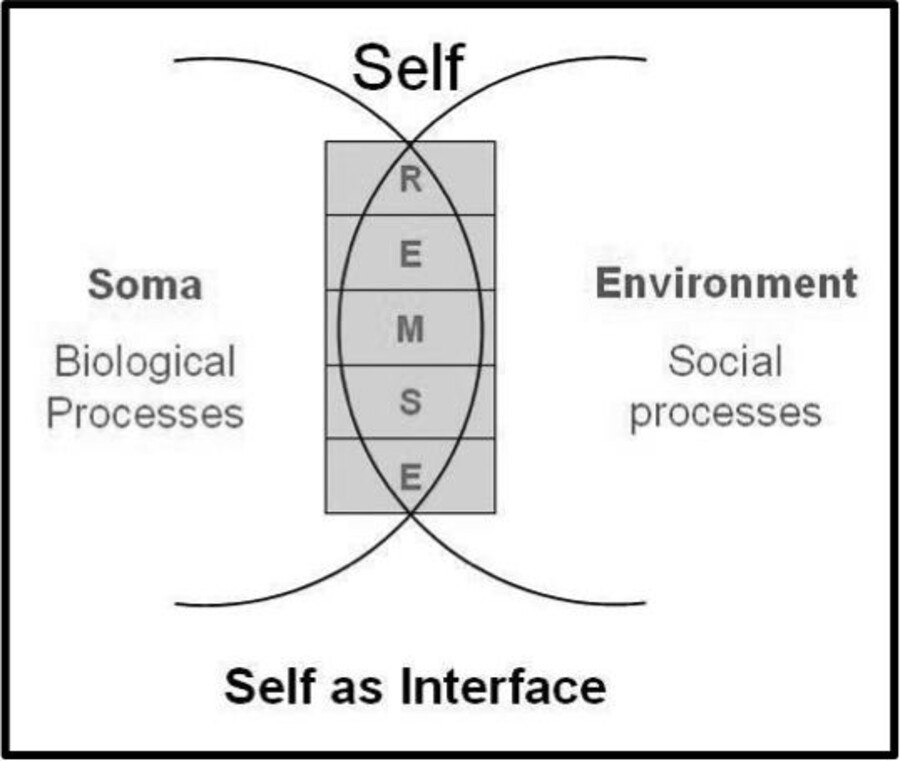
Fig. 1
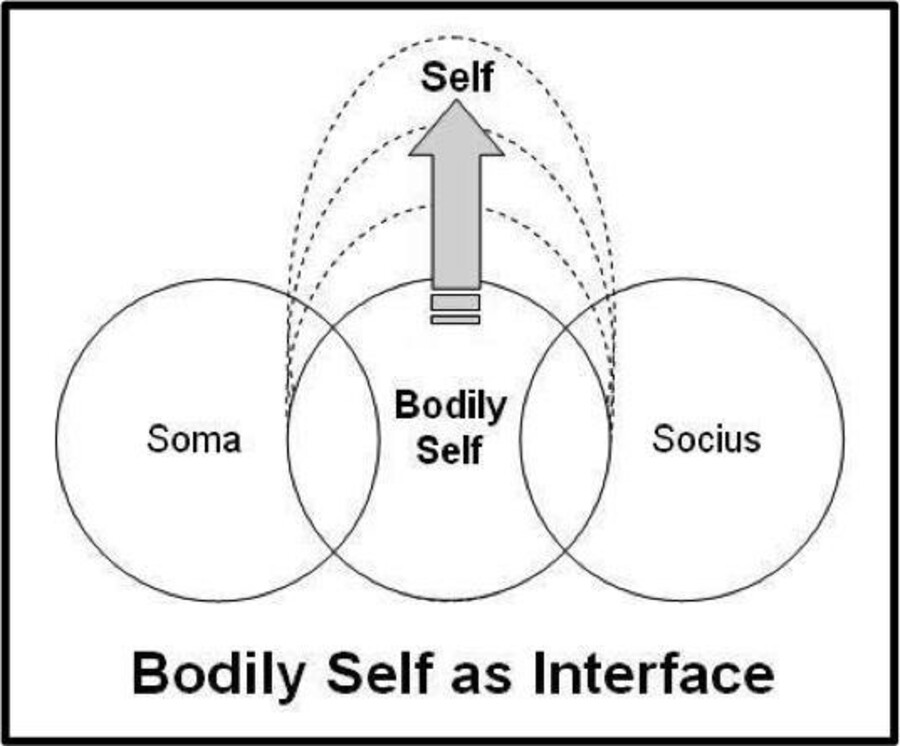
Fig. 2
The bodily Self is the first manifestation of the emerging Self. It is the first subjective reality of the Self and the foundation of its development (figure 2).
Structural Development of The Self
I will use the image of a house: our Self is the house we live in. And similar to building a house, we build our Self step by step. These are the tasks of infancy, the tasks of the 3 first years. The Self, that house, has five floors.
1) The first floor houses the first function: the energetic function
It is the most primitive vital function, the metabolic function that produces energy: for the very functioning of the organism, for its actions and interactions. These vital processes give rise to states of vitality and provide us with the bodily consciousness of existing.
In living beings, including humans, the basic energetic factor is oxygen. We absorb oxygen through respiration. Breathing is one of the fundamental techniques in bioenergetic analysis and experiencing energetic function can begin by exploring breathing and/or restoring a physiological breathing process (figure 3).
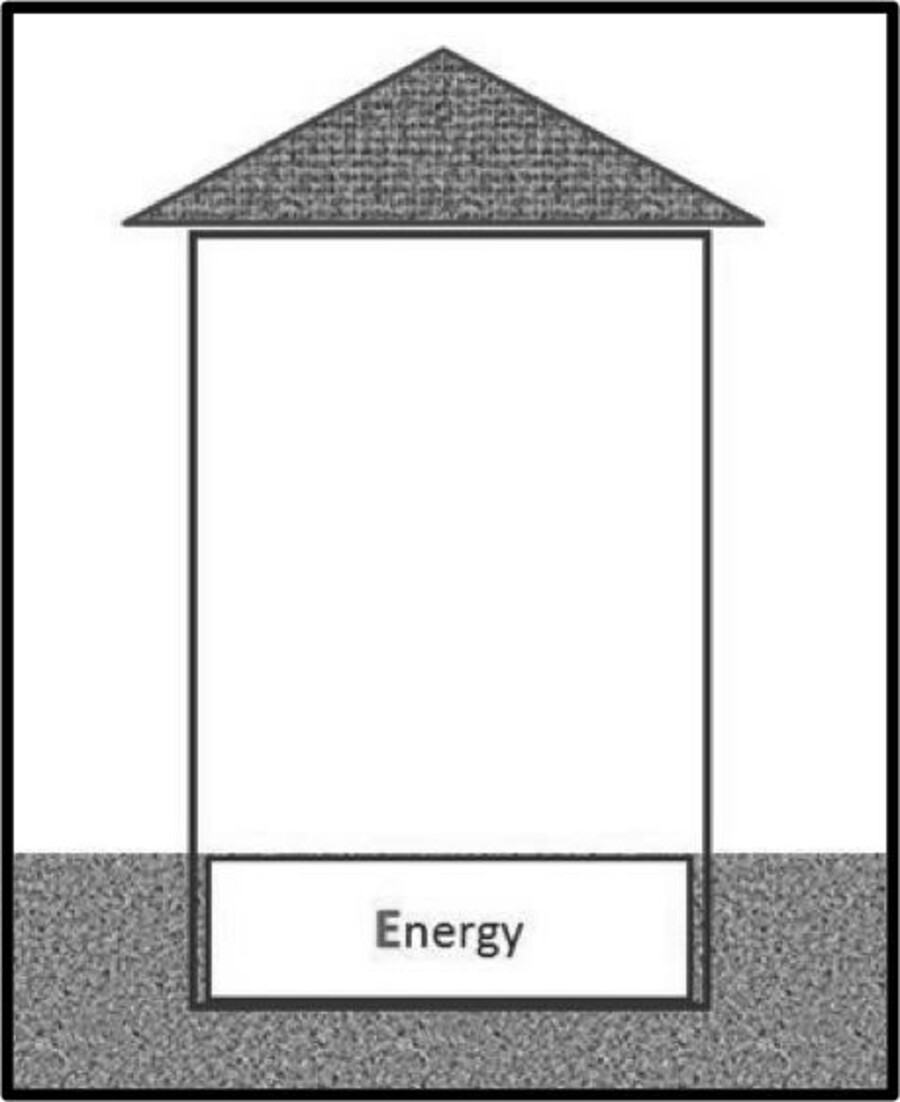
Fig. 3
2) The second floor houses the second function: the sensorial function
Sensorial function collects three types of information:
- interoceptive sensations providing information on the inside world (like hunger or fatigue);
- proprioceptive sensations providing information on the movement of the body (like being seated); and
- exteroceptive sensations providing information on the outside world from the five senses (such as seeing a person walking towards me, or hearing a car going behind my back, or smelling vanilla). These sensations provide us with the bodily consciousness to feel alive and present.
Movement (motility and motricity) produces sensations and can be used for increasing sensorial self-consciousness (figure 4).
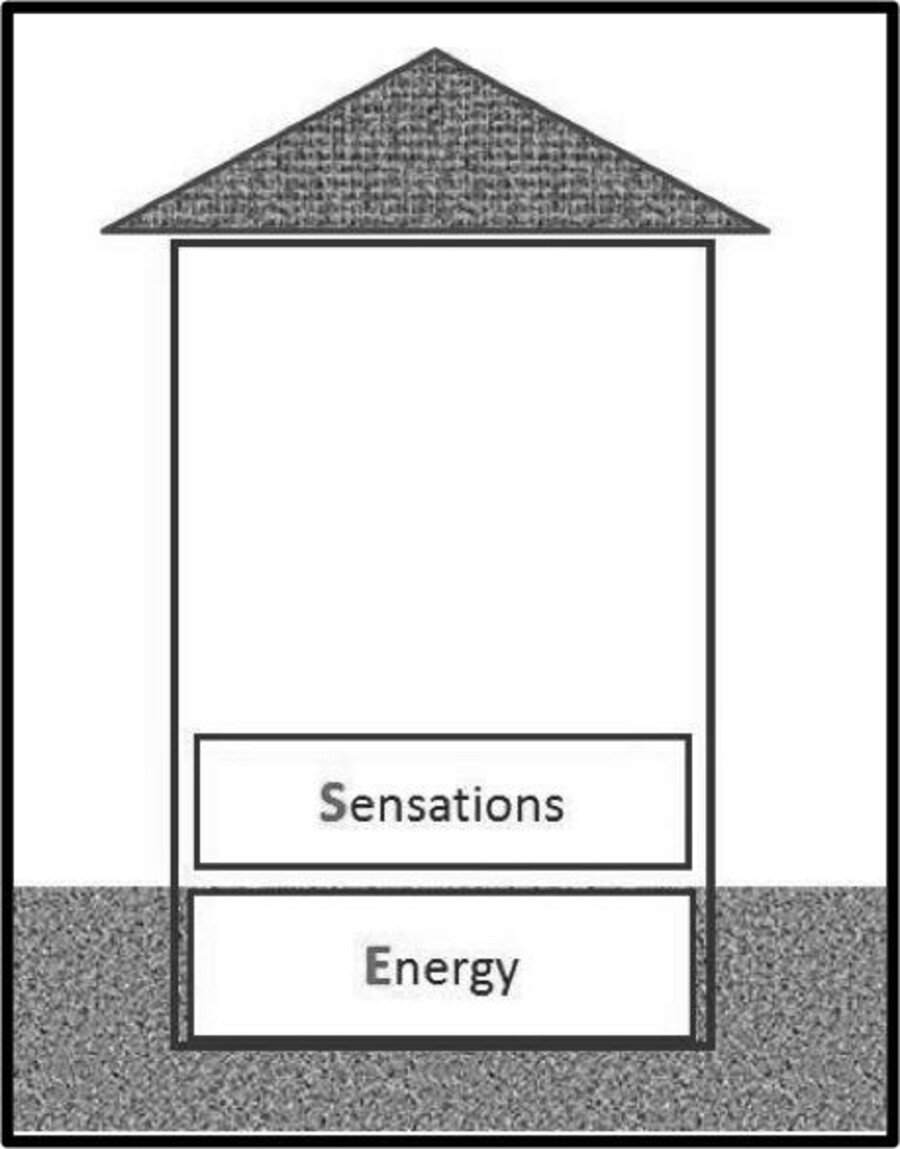
Fig. 4
3) The third floor houses the third function: the muscular or motor function
Musculature has three functions:
- to produce movements for action and interaction by the variations in muscle tone;
- to outline the boundaries of the Self when muscle tone distributed throughout the whole body operates as a "muscular envelope"; and
- to contain internal impulses and drives and regulate self-expression thanks to that “muscular envelope” (figure 5).

Fig. 5
4) The fourth floor houses the fourth function: the emotional function
Emotion has three functions:
- through expression, it plays a cathartic role in the regulation of the Self;
- it plays a role of subjective communication with the social environment; and
- emotions, associated with cognitive information, give a subjective sense and a signification to the current situation (figure 6).

Fig. 6
5) At last, the fifth floor houses the fifth function: the representational function
Representations constantly translate body states coming from the four previous floors into images, words, symbols. This is the floor of cognition and thought. The ability to represent and understand what is happening in and around oneself allows one to think, to create and to act appropriately (figure 7).

Fig. 7
The ESMER Model
So, the Self presents five basic levels of organization: Energetic function, Sensory function, Muscular function, Emotional function, and function of Representation-cognition. This is the “ESMER model”.
Each function supports the next and is built on the previous. The variations which occur in one of the functions of the Self cause variations in each other functions, like a wave moving up and down.
This functional continuity constitutes the life of the integrated and connected Self which remains in perpetual transformation and enrichment throughout life (figure 8).
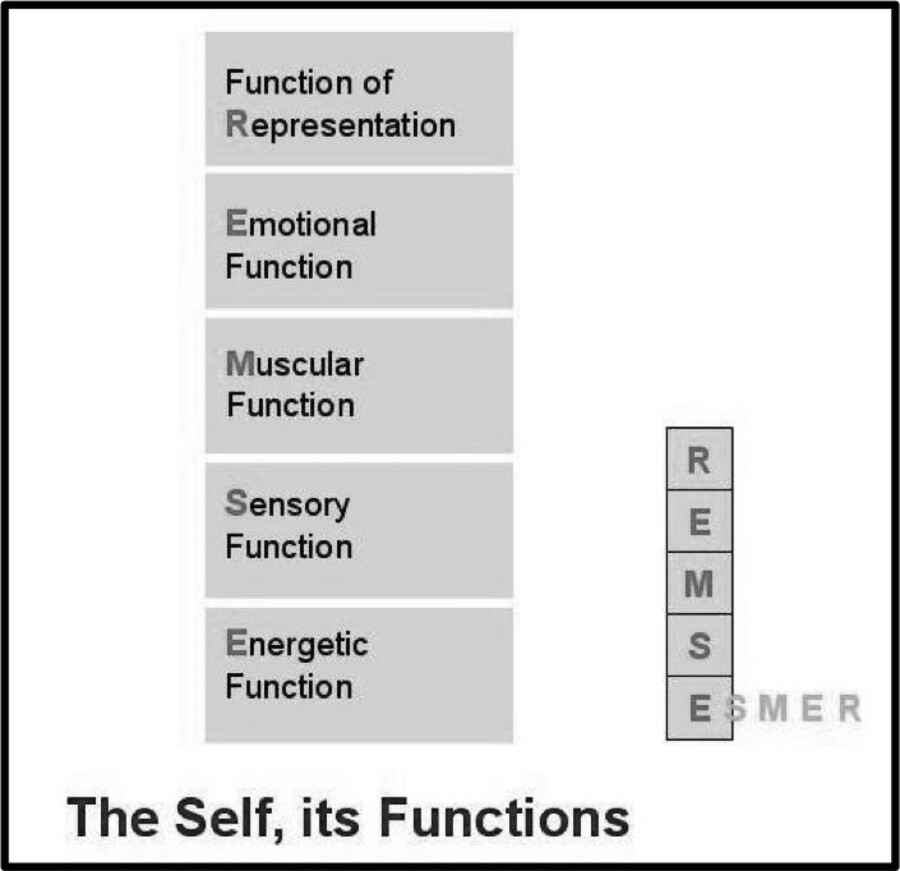
Fig. 8
Functional Development of The Self
Let’s consider again, for a moment, this metaphor of the Self as a house. It is necessary that a house has a good structure but it is also important that it be functional. So, building the Self includes three more functional tasks:
1) Develop A Continuum Connecting The Extremes On Each Floor
This process means moving from an initial immature bipolar functioning (or/or) to a mature associative functioning (and/and). Neurobiological maturation will gradually help, during the first two years, to build bridges between opposite states: between pleasure and pain, hyper and hypotonicity, love and hate, etc.
If the child doesn’t succeed in building those bridges between the opposite states, the functions of the Self will remain split: “I love you” or “I hate you” which is different than “I love you” and sometimes “I hate you” (still loving you).
Just between the extremes is a “centre”, on each floor. Each of these centres verticalizes the Self as a “centred continuity”. It will then be possible to go into the extremes sometimes, knowing, however, how to come back into the centre, that area of “optimal activation” as defined by Siegel (figure 9).
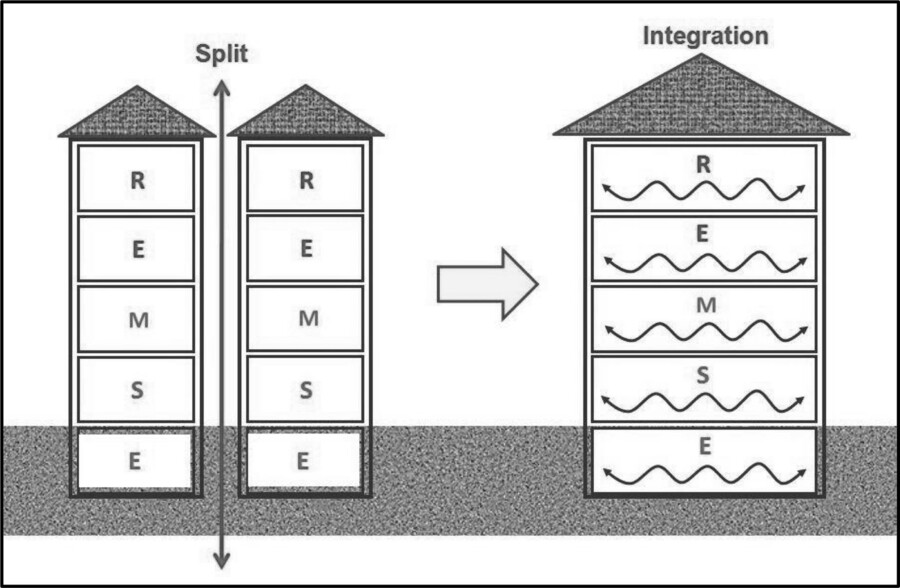
Fig. 9
We will have with some patients – or many of them – to work on the tendency of existing, thinking and communicating from the extremes whichever floor of the Self is involved: energetic, sensorial, muscular, emotional or cognitive. They will have to build the bridges between the extremes. The first experience they could do in therapy, often persuasive, will be muscular: finding, through experience, an “eutonic muscular state”, just between hyper and hypo muscular tone.
2) Build Stairs Between Each Floor
This process means connecting each of these floors to each other so that the self becomes a psychosomatic continuity. Information, from whichever floor it comes, can circulate throughout the house, up and down. This process is that of mindfulness, of the development and global integration of experience (figure 10).

Fig. 10
Like in a house, it then becomes possible to move from one floor to another, stairs connecting each of the floors to the others. In neurobiological terms, it becomes possible to orient your perceptual consciousness on the chosen floor, or to move from one floor to another: energetic, sensory, muscular, emotional, and representational.
But if there are missing stairs from one floor to the other, consciousness cannot take this walk and develop a global awareness of the state of the organism. The elaboration of the information coming from the body will not be able to take place; this psycho-corporal continuity will be missing. The Self will stay in a state of non-integration or dissociation, which is a manifestation of attachment trauma.
3) Build Walls, Doors And Windows in Order to Outline One’s House
It is necessary to perceive one’s own body boundaries, in order to feel oneself as a whole well differentiated from others, in order to contain one’s physiological excitation flows (sensations, emotions, movements), and in order to protect oneself from intrusions and abuse.
Indeed, a house has walls to separate outside and inside and allow intimacy with oneself. It also has doors and windows that can intentionally open or close, to let out or to let in, according to what we decide (figure 11).
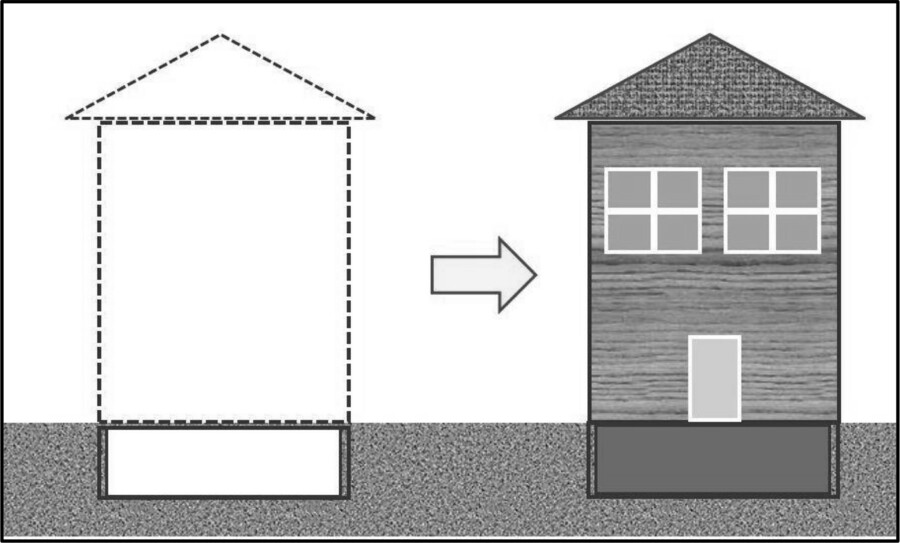
Fig. 11
The muscular tonic envelope constitutes the walls of our Self. It can be more or less tense or relaxed. It is also extremely important to learn to open or to not open the doors and windows of our Self to be more or less in contact with the outside world according to what we need or want at each moment.
If you cannot build the walls, doors and windows of your house, you will be vulnerable, you can be invaded, abused. But you also will not be able to contain what will flow inside of you, your emotions. Without doors and windows to contain your emotional flows inside your house, you can also be invasive.
And finally, you will be in a constant state of alert: not being invaded, not being invasive. You will be in a state of constant dysregulation.
The Four Interconnections Between the Five Functions
Evolution managed to organize the Self into an integrated and self-regulated system by developing connections or links between each of the five functions. These interconnections develop from the stairs built between each floor of the house.
The four interconnections between the five functions were theorized during the first half of the 20th century:
- Freud described the link between representational function and emotional function
- Reich described the link between emotional function and muscular function
- Piaget described the link between muscular function and sensory function
- Lowen described the link between sensory function and energetic function.
These theorizations have prepared a functional conception of the Self, as body-mind continuity (figure 12).
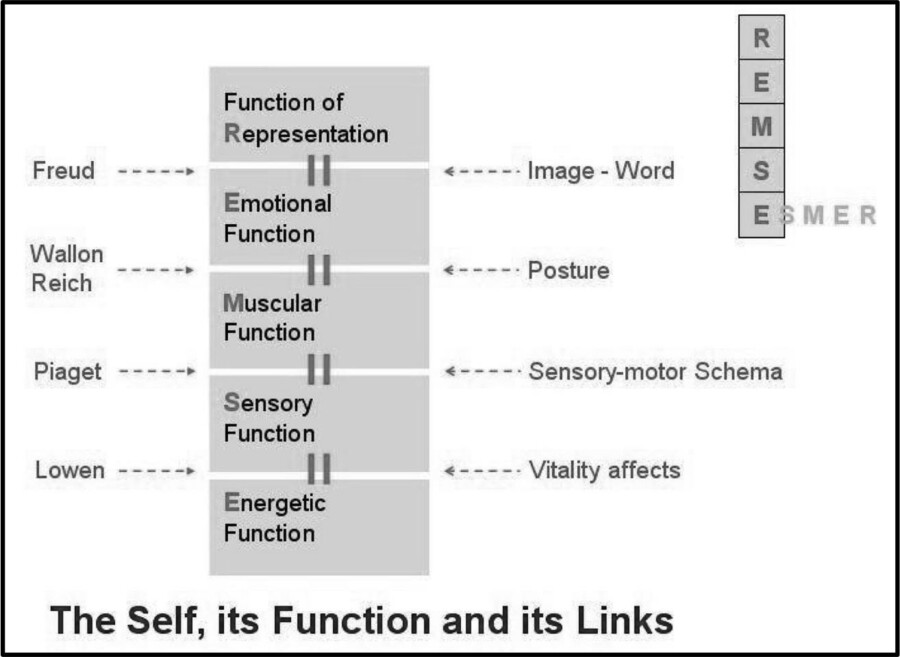
Fig. 12
- The somatosensory link results from the functional connections between energetic function and sensory function. It creates specific states Daniel Stern calls affects of vitality, constantly regulated by homeostatic process.
- The sensorimotor link results from the functional connections between sensory function and muscular function. It creates sensorimotor schemes and patterns that organizes our actions and interactions.
- The tonic-emotional link results from the functional connections between muscular function and emotional function. It creates tonic-emotional patterns using movement and postures for organizing expressiveness, action and interaction.
- The affective-representational link results from the functional connections between emotional function and function of representation. It creates thought patterns connected with feelings that organize our cognitive comprehension and guide our actions.
The Four Relational Modes
The Self, with these 5 functions co-integrated through the functional links, is in constant need of regulation. One uses self-neurobiological regulation but one also needs interpersonal and social regulation.
For that reason and since birth, mother and infant are involved in interpersonal processes that help the baby in the regulation of his Self. Four modes of relationship mother-infant that develop during the first two years of life fulfil this function of regulation (figure 13):
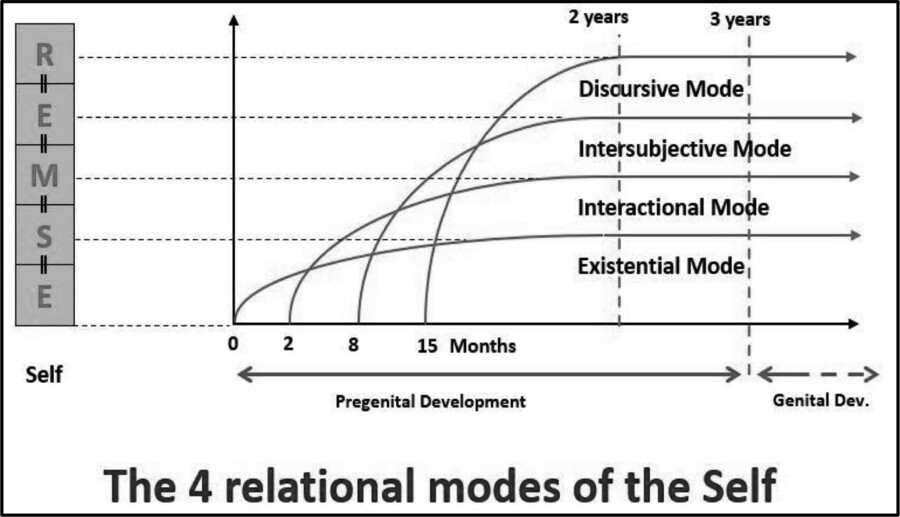
Fig. 13
- The existential mode: it is based on the body feeling of being alive in resonance with the other.
- The interactional mode: it is based on body interactions, through gestures and movements.
- The intersubjective mode: it is based on emotional communication with the other.
- The discursive mode: it is based on the communications with the other through thoughts and ideas.
We will continue to use these four modes of relationship throughout our life if our relationships and culture allow it.
About the Author
Guy Tonella, Dr, is a Doctor in Clinical Psychology, CES of Psycho-physiology, Certified Bioenergetic Therapist, International IIBA Trainer and Faculty member, Co-Director of the Collège Français d’Analyse Bioénergétique. He was Professor of Psychology at Toulouse University for 20 years. He teaches in most European countries and in Argentina, Brazil, Canada, New Zealand and China. He is in private practice in Toulouse in France.